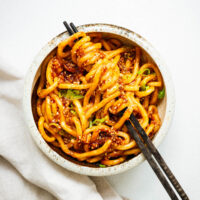
These spicy Korean-style noodles with gochujang noodle sauce are the type of meal I imagine tired chefs rustling up when they get home after a day of cooking. It is simple, quick-and-easy, but absolutely flavour-packed. The portions are small. So if you're super hungry, treat it as a blank canvas to bulk up with stir-fried veggies and tofu, or top it with a fried egg (if you don't need it to stay vegan).
Servings2
Ingredients
- 14 ounces instant fresh udon noodles*
- 1 tablespoon neutral cooking oil
- 3 green onions, sliced (reserve some greens for garnish)
- 2 cloves garlic, minced
- 3 tablespoons sesame seeds, toasted
Gochujang noodle sauce
- 2 tablespoons gochujang paste or more for a spicier sauce
- 2 tablespoons soy sauce
- 2 tablespoons water
- 2 tablespoons rice vinegar
- 1 tablespoon toasted sesame oil
- 1 tablespoon brown sugar
- 1 teaspoon gochugaru (Korean chilli flakes) or red pepper flakes (optional)
Instructions
- Place all the gochujang noodle sauce ingredients – except the optional chilli flakes – in a bowl and whisk to combine. Taste, and add an extra tablespoon of gochujang or a teaspoon of gochugaru if you want more heat. Set aside until needed.
- For fresh udon noodles: Boil water in a pot over high heat. Then cook the fresh udon noodle cakes in boiling water for 2 minutes. Remove the pot from the heat, and use chopsticks to wiggle into the noodles and gently separate them.
- For dried noodles: Cook the noodles according to package instructions stopping a minute short of the full cooking time.
- Drain the cooked noodles, and rinse with cool water.
- Place a wok or non-stick pan over medium-high heat and add the cooking oil. Once the oil is shimmering hot, add the green onions and stir-fry for a minute or two before you add the minced garlic. Cook for another minute until the garlic is fragrant.
- Add the gochujang sauce to the aromatics (be careful, it might sputter). Then cook the sauce to thicken for 3 minutes, stirring often.
- Add the cold noodles and cook for a minute to heat through. Then remove from the heat and stir through the toasted sesame seeds.
- Transfer the noodles to serving bowls and top with the reserved green onions and a sprinkle of chilli flakes if you want extra heat.
Notes
- The udon noodle package may say "pre-cooked", "wok-ready", "fresh noodles" or "instant fresh Japanese noodles". They are thick, white noodles in vacuum-sealed clear plastic (see ingredients and substitutes section for more information). Follow the same cooking instructions for frozen udon noodles, but boil them for a minute longer.
- I love how the gochujang noodle sauce clings to thick, chewy udon noodles. But you can use any Asian wheat noodle in this recipe. Adjust the portion size according to the dried noodle packaging (ramen noodle portions are typically around 2 oz).
- Gochujang is available in different levels of spiciness: Mild, Slight Hot, Medium Hot, Very Hot and Extreme Hot. I buy mine medium hot and add gochugaru (Korean chilli flakes) if I want more heat. Find more information on gochujang and how to substitute it if you've run out.
- I prefer these spicy noodles served warm. But you can also serve them at room temperature.
- Refrigerate leftovers in an airtight container for up to 4 days and reheat with a splash of water.
- See the full post for gochujang noodle variations and optional add-ins to bulk up your noodles.